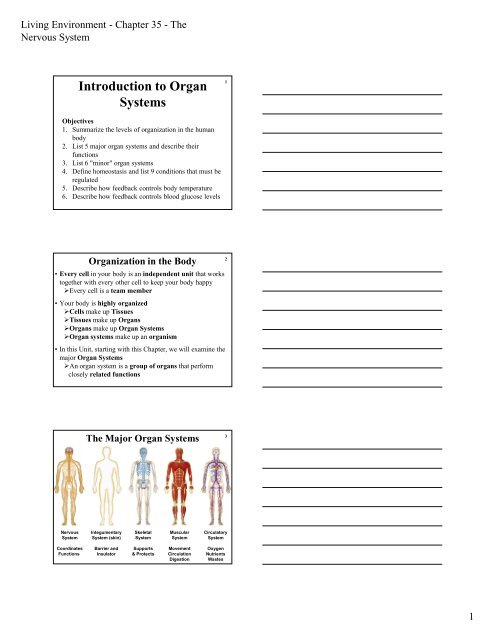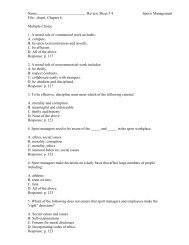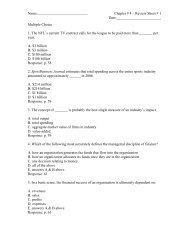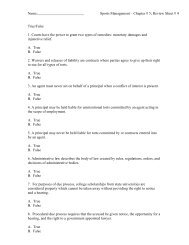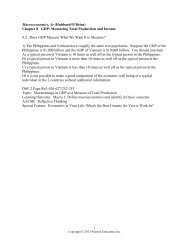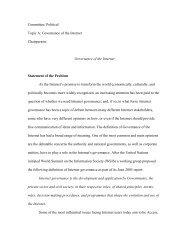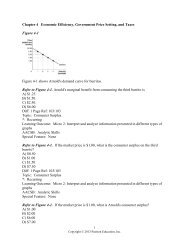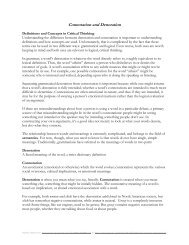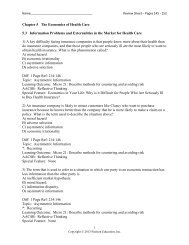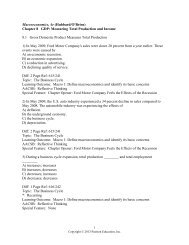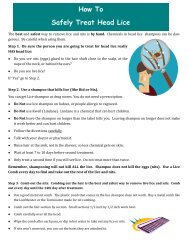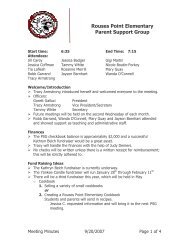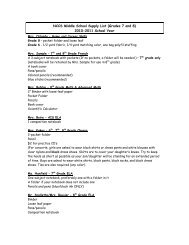Chapter 35 - The Nervous System - Home Page of the Cougars!
Chapter 35 - The Nervous System - Home Page of the Cougars!
Chapter 35 - The Nervous System - Home Page of the Cougars!
Create successful ePaper yourself
Turn your PDF publications into a flip-book with our unique Google optimized e-Paper software.
Living Environment - <strong>Chapter</strong> <strong>35</strong> - <strong>The</strong><strong>Nervous</strong> <strong>System</strong><strong>Home</strong>ostasis & Feedback• <strong>Home</strong>ostasis is a Feedback <strong>System</strong> like <strong>the</strong> <strong>the</strong>rmostat in aroom<strong>The</strong>rmostat senses tempchange and switches <strong>of</strong>fheating system7Room temperatureincreasesFeedbackRegulationRoom temperaturedecreases<strong>The</strong>rmostat senses tempchange and switches onheating system<strong>Home</strong>ostasis, Feedback & Body Temp 8• <strong>Home</strong>ostasis in your body uses Feedback <strong>System</strong>s• Heat loss and heat production are carefully balancedMaintains 98.6°F (37°C)Controlled by Hypothalamus in <strong>the</strong> brainMonitors skin temp and core organ temp– Shivering is how <strong>the</strong> body raises temp when youget too cold– A signal from Hypothalamus to muscles in skinWhen you get too hot, <strong>the</strong> Hypothalamus sends asignal to sweat glands– Evaporation <strong>of</strong> sweat cools <strong>the</strong> body• <strong>Home</strong>ostasis in your body is controlled by <strong>the</strong> Brain<strong>Home</strong>ostasis, Feedback & Glucose• <strong>Home</strong>ostasis in your body uses Feedback <strong>System</strong>s• GlucoseWhen you eat, glucose (sugar) from food enters yourbloodHigh blood glucose triggers release <strong>of</strong> <strong>the</strong> hormoneinsulin from <strong>the</strong> pancreasControlled by Hypothalamus in <strong>the</strong> brainInsulin causes blood sugar to be absorbed into liver,muscle and fat (excess) cellsIf blood glucose gets too low, <strong>the</strong> pancreas releases <strong>the</strong>hormone glucagon, which causes sugar to be released• <strong>Home</strong>ostasis in your body is controlled by <strong>the</strong> Brain93
Living Environment - <strong>Chapter</strong> <strong>35</strong> - <strong>The</strong><strong>Nervous</strong> <strong>System</strong><strong>Chapter</strong> <strong>35</strong> Vocab131. Axon2. Central <strong>Nervous</strong> <strong>System</strong>3. Cerebellum4. Cerebrum5. Dendrite6. <strong>Home</strong>ostasis7. Hypothalamus8. Neuron9. Neurotransmitter10.Sensory Receptor11.Synapse12.Thalamus13.Tympanic MembraneDefinitions are due in 2 days !!Section 1: Neurons14Objectives1. Identify <strong>the</strong> role <strong>of</strong> neurons2. List 3 types <strong>of</strong> neurons3. Describe <strong>the</strong> structure <strong>of</strong> a neuron4. Define a synapse and summarize <strong>the</strong>events that occur <strong>the</strong>re5. Define a neurotransmitter and list 4 types• Cells that transmitinformationNeurons: Nerve Cells15• Enable all activitiesMovement,perception, thought,emotion, and learning• Interconvert betweenelectrical signals(impulses) and chemicalsignalshttp://www.sprechstundem21.unibe.ch/neurons-1.jpg5
Living Environment - <strong>Chapter</strong> <strong>35</strong> - <strong>The</strong><strong>Nervous</strong> <strong>System</strong>• DendritesExtend from cell bodyReceive info fromo<strong>the</strong>r cellsRelays info to <strong>the</strong> CellBody• Cell BodyRelays info to o<strong>the</strong>rparts <strong>of</strong> a neuronStructure <strong>of</strong> a Neurondendrites cell body axon• AxonLong extension <strong>of</strong> <strong>the</strong> cellConducts nerve impulseto a Synapse• Synapse – not part <strong>of</strong> NeuronAxon terminal<strong>The</strong> place where a signaltravels to a new cellCan be a gland, muscleor o<strong>the</strong>r neuronsynapse19http://faculty.washington.edu/chudler/fillin1.html• Neurons do not touch• <strong>The</strong>re is a small gapbetween <strong>the</strong> axonterminal and <strong>the</strong> nextneuron (or muscle orgland)This gap is called <strong>the</strong>Synapse• A signal crosses <strong>the</strong>synapse whenNeurotransmitters arereleased from an axon<strong>The</strong> Synapse• NeurotransmittersChemicals (mostly aminoacids or proteins) that cross<strong>the</strong> synapse to stimulate <strong>the</strong>next cellLeft-overneurotransmitters areremoved to prevent overstimulationNeurotransmitters include:DopamineAcetylcholineGlutamateSerotonin20A Nerve Impulse• Nerve impulses are transmitted from dendrite to axonAlong a nerve by sodium and potassium ions – electricalAcross a synapse by Neurotransmitters – chemical21http://www.kankada.com/neurons_mac.shtmlsynapseneurotransmitters7
Living Environment - <strong>Chapter</strong> <strong>35</strong> - <strong>The</strong><strong>Nervous</strong> <strong>System</strong>Synapse: “<strong>The</strong> Space Between”22http://www.txtwriter.com/Backgrounders/Drugaddiction/synapse.jpgReview Questions231. What are <strong>the</strong> three main parts <strong>of</strong> a neuron?2. What is <strong>the</strong> name <strong>of</strong> <strong>the</strong> insulation around some neurons?3. In which direction does an impulse travel through aneuron?4. What is <strong>the</strong> space between neurons called?5. What molecule crosses <strong>the</strong> synapse and stimulates <strong>the</strong>next cell?Section 2: <strong>The</strong> <strong>Nervous</strong> <strong>System</strong>24Objectives1. List <strong>the</strong> 2 primary divisions <strong>of</strong> <strong>the</strong> nervous systemand describe <strong>the</strong>ir functions2. Identify <strong>the</strong> 5 key areas <strong>of</strong> <strong>the</strong> brain and list <strong>the</strong>irkey functions3. Understand <strong>the</strong> function and structure <strong>of</strong> <strong>the</strong>spinal cord4. List <strong>the</strong> 2 main parts <strong>of</strong> <strong>the</strong> Peripheral <strong>Nervous</strong><strong>System</strong>5. Identify <strong>the</strong> functions <strong>of</strong> <strong>the</strong> Somatic <strong>Nervous</strong><strong>System</strong> and <strong>the</strong> Autonomic <strong>Nervous</strong> <strong>System</strong>8
Living Environment - <strong>Chapter</strong> <strong>35</strong> - <strong>The</strong><strong>Nervous</strong> <strong>System</strong><strong>The</strong> <strong>Nervous</strong> <strong>System</strong>25• <strong>The</strong>re are 2 primary divisions <strong>of</strong> <strong>the</strong> Human<strong>Nervous</strong> <strong>System</strong>1.<strong>The</strong> Central <strong>Nervous</strong> <strong>System</strong> (CNS)<strong>The</strong> Brain and Spinal Cord<strong>The</strong> control center for <strong>the</strong> body – <strong>the</strong> CPU2.<strong>The</strong> Peripheral <strong>Nervous</strong> <strong>System</strong> (PNS)Receives and transmits info from <strong>the</strong> worldto <strong>the</strong> brain<strong>The</strong> Central <strong>Nervous</strong> <strong>System</strong> (CNS)26CerebrumThalamusPinealglandHypothalamusPituitary glandPonsMedulla oblongataCerebellumSpinal cord<strong>The</strong> Central <strong>Nervous</strong> <strong>System</strong> (CNS)• <strong>The</strong>re are 5 key parts <strong>of</strong> <strong>the</strong> Brain1. Cerebrum - <strong>the</strong> largest part <strong>of</strong> brainLearning, memory, perceptionand intelligence, personality,Cerebrumdecision-makingAlzheimer’s DiseaseRight and left hemispheres– Right brain” and “left brain”– Right brain controls left half <strong>of</strong> body– Left brain controls right half <strong>of</strong> bodyCerebral cortex – a thin outer layer– Sensory and motor processing– Folds on surface add surface area279
Living Environment - <strong>Chapter</strong> <strong>35</strong> - <strong>The</strong><strong>Nervous</strong> <strong>System</strong>Phineas Gage28• In 1860, a RR worker had ametal rod driven thru hisskull• He lost an eye and sufferedsevere personalitychanges, but was still ableto speak and walk• This accident was <strong>the</strong> firstevidence for <strong>the</strong> role <strong>of</strong> <strong>the</strong>Cerebrum on personalityand behaviorhttp://en.wikipedia.org/wiki/File:Phineas_gage_-_1868_skull_diagram.jpghttp://www.sciencemuseum.org.uk/exhibitions/brain/images/1-1-8-3-1-1-1-0-0-0-0.jpg<strong>The</strong> Cerebellum & Brain Stem2. CerebellumBalance, posture,and movementParkinson’s Disease3. Brain StemConnects brain andspinal cordPonsBreathingMedullaOblongata Heart rate &BP,swallowingPonsMedullaoblongataSpinal cord29CerebellumThalamus & Hypothalamus4. Thalamus<strong>The</strong> relay station for sensory impulses305. HypothalamusControls body temp, water, glucose, metabolism<strong>Home</strong>ostasisHunger, pain, and pleasureHypothalamusThalamus10
Living Environment - <strong>Chapter</strong> <strong>35</strong> - <strong>The</strong><strong>Nervous</strong> <strong>System</strong><strong>The</strong> Spinal Cord31• <strong>The</strong> Spinal CordInfo travels from bodyup spinal cord to brain,brain sends message back31 pairs <strong>of</strong> nerves branchto body from hereControls ReflexesQuick automaticresponse to a stimulusSneezing, blinkingDamage to disks causespinched nervesSciaticahttp://www.sci-recovery.org/images/vertebraeandspinalcord.jpgReview Questions321. What is <strong>the</strong> Central <strong>Nervous</strong> <strong>System</strong>?2. Name <strong>the</strong> 5 main parts <strong>of</strong> <strong>the</strong> brain.3. What part <strong>of</strong> <strong>the</strong> brain controls your personality?4. Where are <strong>the</strong> Reflexes found?<strong>The</strong> Peripheral <strong>Nervous</strong> <strong>System</strong> (PNS) 33• Made <strong>of</strong> 2 parts1.<strong>The</strong> Somatic <strong>Nervous</strong> <strong>System</strong>2.<strong>The</strong> Autonomic <strong>Nervous</strong> <strong>System</strong>• <strong>The</strong> PNS connects CNS to rest <strong>of</strong>body1.Somatic <strong>Nervous</strong> <strong>System</strong> (SNS)Conscious muscle controlSkeletal musclesCritical for some reflexes alsohttp://www.<strong>the</strong>brain.mcgill.ca/flash/i/i_01/i_01_cr/i_01_cr_ana/i_01_cr_ana_2a.jpg11
Living Environment - <strong>Chapter</strong> <strong>35</strong> - <strong>The</strong><strong>Nervous</strong> <strong>System</strong>Review Questions1. Where in <strong>the</strong> brain is all Sensory Information processed?432. What do Rod and Cone cells do?3. What is ano<strong>the</strong>r name for <strong>the</strong> Tympanic Membrane?4. What type <strong>of</strong> cells are nasal Sensory Receptors found in?5. What type <strong>of</strong> sensory receptor is involved in detecting:a. Temperatureb. Touch and soundc. Lightd. Taste and smellAddiction• Drugs alter <strong>the</strong> normal functioning <strong>of</strong> neurons andsynapses<strong>The</strong>y can’t functionunless <strong>the</strong> drug is presentToleranceIncreasing amounts<strong>of</strong> <strong>the</strong> drug are neededto achieve <strong>the</strong> same“high”WithdrawalEmotional andphysical symptomscaused by stoppinguse <strong>of</strong> <strong>the</strong> drug44• Addictive SubstancesStimulantsCaffeineNicotineCocaineMethamphetamine– CrankDepressantsAlcoholOpiatesBarbituratesCodeineCocaine Addiction:Changes in Neuron Function45• Stimulantslike cocainecausehyperactivityat synapses,which is why<strong>the</strong>y stimulatehttp://www.utexas.edu/research/asrec/drugs.gif15


